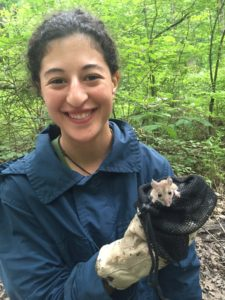18: Appendix B- Primate Conservation
- Page ID
- 158845
Acknowledgments
We are grateful to the University of Wisconsin-Madison for the various sources of funding that enabled us to write this Appendix, including Teaching Assistantships from the departments of Integrative Biology (to MPD and JBK) and Anthropology (to RJE and AJH), an Advanced Opportunity Fellowship (to IEA), and a Vilas Research Professorship (to KBS). We are grateful to our new lab member, Irene Duch Latorre, for her photograph and helpful additions as well as to Kadie Callingham for the use of her photograph. We thank the editors of this volume for inviting our contribution and for the helpful comments that they and an anonymous reviewer provided.
About the Authors
Mary P. Dinsmore, M.S., Ph.D. candidate
University of Wisconsin–Madison

Mary P. Dinsmore is a Ph.D. candidate in the Department of Environment and Resources at the University of Wisconsin–Madison and a member of the Strier Lab. Mary’s interest in primatology began when she was working as a research assistant in Peru with saddleback tamarins (Saguinus fuscicollis) and in Madagascar with greater bamboo lemurs (Prolemur simus). It was during these experiences that she saw firsthand the immense impacts that humans had on primate habitat and became interested in human-wildlife conflict and conservation. Her dissertation work explores the consequences of anthropogenic and natural disturbances on the habitat and behavior of the northern sportive lemur (Lepilemur septentrionalis). She has received funding for this work from the Primate Action Fund of Conservation International and African Studies Department of UW–Madison. Mary received her BS and BA from the University of Portland in 2009 and her MS from the University of Wisconsin–Madison in 2014. She currently teaches study abroad with Broadreach Global Adventures as well as throughout the academic year in the Department of Integrative Biology at UW–Madison.
Ilianna E. Anise, B.A., Ph.D. student
University of Wisconsin–Madison

Ilianna E. Anise is a Ph.D. student in the Integrative Biology department at the University of Wisconsin–Madison. She is a member of the Strier Lab, studying primate behavioral ecology and conservation. Ilianna’s current research focuses on studying vigilance and risk in black-horned capuchin monkeys (Sapajus nigritus) in southeast Brazil. She holds an Advanced Opportunity Fellowship and has received funding from the Department of Integrative Biology. Ilianna received her BA in biology and environmental science from Drew University. She found her passion for fieldwork while participating in a small mammal demography research project as an undergraduate student. At UW–Madison, Ilianna is a teaching assistant for an animal biology lab course and enjoys sharing her love of animals with students.
Rebekah J. Ellis, B.A., M.S.
University of Wisconsin–Madison

Rebekah J. Ellis is a Ph.D. student in the Department of Anthropology at the University of Wisconsin–Madison. She is a member of the Strier Lab. Rebekah received her BA in anthropology and psychology from the University of Texas at Austin. She has studied the behavior of neotropical primates at field sites in Eastern Costa Rica and the Ecuadorian Amazon. At UW–Madison, Rebekah has assisted in teaching an introductory course covering the subdisciplines of cultural, archeological, and biological anthropology. She currently holds a Foreign Language and Area Studies Fellowship. Her research utilizes social network analysis to explore the social behavior of neotropical primates.
Amanda J. Hardie, M.A., Ph.D. candidate
University of Wisconsin–Madison

Amanda J. Hardie is a Ph.D. Candidate in Anthropology at the University of Wisconsin–Madison and a member of the Strier Lab. Amanda received her BA in Anthropology at the University of North Carolina-Charlotte, after attending Central Piedmont Community College. Amanda’s research focuses on the dynamic interactions between primates and the environment, and she currently works in Brazil studying the behavior and diet of brown howler monkeys in the Atlantic Forest. She has received funding from the Department of Anthropology, a Foreign Language Area Studies Fellowship, and the National Geographic Society.
Jacob B. Kraus, B.A., Ph.D. student
University of Wisconsin–Madison

Jacob B. Kraus is a Ph.D. student and teaching assistant in the Department of Integrated Biology at the University of Wisconsin–Madison and a member of the Strier Lab. His interest in primatology began while studying the ecology and behavior of Gelada monkeys (Theropithecus gelada) as a field assistant for the Guassa Gelada Research Project (GGRP) in Ethiopia. He is broadly interested in the behavioral thermoregulation strategies that primates, and other social mammals, employ in high-altitude habitats. Jacob’s current research is focused on how the sociality of Yunnan snub-nosed monkeys (Rhinopithecus bieti) affects their microhabitat selection and grooming behaviors. He has been funded by the Department of Integrative Biology. Jacob received his BA in Biology from Reed College. Prior to attending UW–Madison, Jacob interned at the Smithsonian Conservation Biology Institute (SCBI), where he worked on various remote sensing and habitat survey projects.
Karen B. Strier, Ph.D.
University of Wisconsin–Madison

Karen B. Strier is Vilas Research Professor and Irven DeVore Professor of Anthropology at the University of Wisconsin–Madison. After graduating from Swarthmore College in 1980, she received her MA in 1981 and her PhD in 1986 in Anthropology from Harvard University. She is an international authority on the endangered northern muriqui monkey, which she has been studying in the Brazilian Atlantic forest since 1982. Her pioneering, long-term field research has been critical to conservation efforts on behalf of this species, and has been influential in broadening comparative perspectives on primate behavioral and ecological diversity. She is a fellow of the U.S. National Academy of Sciences, the American Academy of Arts and Sciences, and the American Association for the Advancement of Science. She was awarded an Honorary Doctorate of Science from the University of Chicago, and Distinguished Primatologist Awards from the American Primatological Society and the Midwestern Primate Interest Group. She has received various research, teaching, and service awards from the University of Wisconsin–Madison and has been honored with Lifetime Honorary Memberships from the Brazilian Primatological Society and the Latin American Primatological Society, and with Honorary Citizenship of the city of Caratinga, in Minas Gerais, Brazil. She has authored or coauthored more than 100 publications, in addition to working on various coauthored and edited volumes and two single-authored books, Faces in the Forest: The Endangered Muriqui Monkeys of Brazil (1992) and Primate Behavioral Ecology, 5th edition (2017). Since 2016, she has served as the elected President of the International Primatological Society.

